The Influence of Graphite Orientation on the Current-Carrying Friction Performance of Copper–Graphite Composite Materials
Abstract
1. Introduction
2. Materials and Methods
2.1. Materials
2.2. Experimental Methods
3. Results
3.1. The Effect of Graphite Orientation on the Physical Properties of Copper–Graphite Composites
3.2. The Effect of Graphite Orientation on the Current-Carrying Friction and Wear Properties of Copper–Graphite Composites
3.3. The Effect of Graphite Orientation on the Current-Carrying Performance of Copper–Graphite Composites
3.4. The Effect of Graphite Orientation on the Current-Carrying Friction and Wear Behavior of Copper–Graphite Composites
3.5. Three-Dimensional Morphology of the Wear Surfaces of Composites with Different Graphite Orientations
3.6. Analysis of the Wear Surface Behavior of Composites with Different Graphite Orientations
3.7. Graphite on the Wear Surface
4. Discussion
5. Conclusions
Author Contributions
Funding
Data Availability Statement
Conflicts of Interest
References
- Guo, F.Y.; Gu, X.; Wang, Z.Y.; Wang, Y.; Wang, X. Simulation on Current Density Distribution of Current-Carrying Friction Pair Used in Pantograph-Catenary System. IEEE Access 2020, 8, 25770–25776. [Google Scholar] [CrossRef]
- Li, S.B.; Yang, X.; Kang, Y.Q.; Li, Z.Y.; Li, H.W. Progress on current-carry friction and wear: An overview from measurements to mechanism. Coatings 2022, 12, 1345. [Google Scholar] [CrossRef]
- Hung, P.V.; Bao, L.D.; Duong, N.T. Effect of Humid Tropical Climate and Electrical Current on the Electrical Sliding Wear Behavior of Graphite Brush in Motor. J. Tribol. 2023, 145, 031704. [Google Scholar] [CrossRef]
- JB/T 12252-2015; Brush for Wind Driven Generator. Machinery Industry Standards of the People’s Republic of China: Beijing, China, 2015. (In Chinese)
- Wu, G.N.; Dong, K.L.; Xu, Z.L.; Xiao, S.; Wei, W.F.; Chen, H.; Li, J.; Huang, Z.L.; Li, J.W.; Gao, G.Q.; et al. Pantograph–catenary electrical contact system of high-speed railways: Recent progress, challenges, and outlooks. Railw. Eng. Sci. 2022, 30, 437–467. [Google Scholar] [CrossRef]
- He, Z.J.; Ni, Z.R.; Wang, H.; Yang, Z.; Wei, W.; Wang, X.; Deng, L.; Wu, G. Effect of Magnetic Field on the Current-carrying Friction and Wear Performance of C/Cu Contact Pairs. In Proceedings of the 2021 International Conference on Electrical Materials and Power Equipment (ICEMPE), Chongqing, China, 11–15 April 2021. [Google Scholar] [CrossRef]
- Fu, Y.; Qin, H.; Xu, X.; Zhang, X.; Guo, Z. What are the Progresses and Challenges, from the Electrical Properties of Current-Carrying Friction System to Tribological Performance, for a Stable Current-Carrying Interface? J. Bio-Tribo-Corros. 2022, 8, 4. [Google Scholar] [CrossRef]
- Rajkumar, K.; Kundu, K.; Aravindan, S.; Kulkarni, M. Accelerated wear testing for evaluating the life characteristics of copper–graphite tribological composite. Mater. Des. 2011, 32, 3029–3035. [Google Scholar] [CrossRef]
- Yan, Y.F.; Kou, S.Q.; Yang, H.Y.; Shao, Y.; Qiu, F.; Shu, S.L. Synergistic optimization of mechanical and tribological properties of TiC modified copper-graphite composites by direct current in-situ sintering. Ceram. Int. 2023, 49, 27069–27078. [Google Scholar] [CrossRef]
- Su, Y.M.; Jiang, F.; Xiao, Z.Y.; Wu, F.; Long, M. Microstructure and tribological properties of copper/graphite composites with Ti3AlC2 addition prepared by rapid hot press sintering. Tribol. Int. 2024, 194, 109537. [Google Scholar] [CrossRef]
- Zhao, J.; Peng, Y.T.; Zhou, Q.G.; Zou, K. The current-carrying tribological properties of Cu/Graphene composites. J. Tribol. 2021, 143, 102101. [Google Scholar] [CrossRef]
- Zhu, L.Y.; Yi, M.; Wang, L.M.; Chen, S. Effects of foam copper on the mechanical properties and tribological properties of graphite/copper composites. Tribol. Int. 2020, 148, 106164. [Google Scholar] [CrossRef]
- Morvan, A.; Grosseau-Poussard, J.; Caillault, N.; Delange, F.; Roure, S.; Lepretre, P.; Silvain, J.-F. Powder processing methodology for fabrication of Copper/Graphite composite materials with enhanced thermal properties. Compos. Part A Appl. Sci. Manuf. 2019, 124, 105474. [Google Scholar] [CrossRef]
- Kováčik, J.; Emmer, Š.; Bielek, J.; Keleši, L.U. Effect of composition on friction coefficient of Cu–graphite composites. Wear 2008, 265, 417–421. [Google Scholar] [CrossRef]
- Ge, Y.X.; Yang, Z.H.; Sun, L.M.; Zhang, Y.Z.; Zhang, J.W. Effect of sintering temperature on properties of copper-graphite composite materials. Trans. Mater. Heat Treat. 2019, 40, 8–14. [Google Scholar]
- Yang, Z.H.; Ge, Y.X.; Zhang, X.; Shangguan, B.; Zhang, Y.; Wang, Y. Effect of Particle Size on Current-Carrying Friction and Wear Properties of Copper-Graphite Composites by Spark Plasma Sintering. Materials 2019, 12, 2825. [Google Scholar] [CrossRef]
- Yang, Z.H.; Ge, Y.X.; Zhang, X.; Shangguan, B.; Zhang, Y.; Zhang, J. Effect of carbon content on friction and wear properties of copper matrix composites at high speed current-carrying. Materials 2019, 12, 2881. [Google Scholar] [CrossRef]
- Lu, J.; Ma, C.; Zhang, L.; He, Z.; Guo, B.; Wei, J.; Zeng, D.; Li, W.; Liu, Y. Effect of normal load on damage mechanism of gradient copper-graphite composites under electric current. Wear 2025, 562, 205653. [Google Scholar] [CrossRef]
- Zhou, Y.K.; Du, M.D.; Zuo, X. Influence of Electric Current on the Temperature Rise and Wear Mechanism of Copper–Graphite Current-Carrying Friction Pair. J. Tribol. 2022, 144, 101701. [Google Scholar] [CrossRef]
- Liu, X.L.; Cai, Z.; Liu, S.T.; Wu, S.B.; Zhu, M.H. Influence of wear test parameters on the electrical contact performance of brass alloy/copper contactors under fretting wear. J. Mater. Eng. Perform. 2019, 28, 817–827. [Google Scholar] [CrossRef]
- Grandin, M.; Wiklund, U. Wear phenomena and tribofilm formation of copper/copper-graphite sliding electrical contact materials. Wear 2018, 398, 227–235. [Google Scholar] [CrossRef]
- Wen, S.Z.; Huang, P. Principles of Tribology, 2nd ed.; Tsinghua University Press: Beijing, China, 2017. [Google Scholar]
- Hao, W.; Xia, Y.; Yi, Z. Current carrying tribological properties of multi arc ion plated titanium nitride doped silver coating. Mater. Res. Express 2024, 11, 056401. [Google Scholar] [CrossRef]
- Rong, M.Z.; Ma, Q.; Wu, Y.; Xu, T.; Murphy, A.B. The influence of electrode erosion on the air arc in a low-voltage circuit breaker. J. Appl. Phys. 2009, 106, 023308. [Google Scholar] [CrossRef]
- Zhao, L.J.; Li, Z.B.; Shi, K.Y.; He, J.; Li, H. Electrical properties of nanocrystalline CuCr25 contact material. IEEE Trans. Compon. Packag. Manuf. Technol. 2012, 3, 625–632. [Google Scholar] [CrossRef]
- Liu, X.L.; Hu, M.J.; Li, Z.H.; Zhou, C.; Xiao, Q.; Yang, W.; Chen, D. Effect of copper contents on the current-carrying wear properties of carbon brush under different temperatures conditions. J. Mater. Res. Technol. 2021, 15, 3110–3121. [Google Scholar] [CrossRef]
- Sun, K.; Diao, D. Current density effect on current-carrying friction of amorphous carbon film. Carbon 2020, 157, 113–119. [Google Scholar] [CrossRef]
- Yang, Z.; Song, Y.; Jiao, J.; Li, W.; Shangguan, B.; Zhang, Y. Optimization of current-carrying friction and wear properties of copper-carbon composite materials based on damage. Tribol. Int. 2024, 191, 109074. [Google Scholar] [CrossRef]
- Jung, K.H.; Nam, S.; Kang, S.S.; Ku, B.-C.; Bang, Y.H.; Hwang, J.Y. Tribological properties of carbon fiber-reinforced aluminum composites processed by spark plasma sintering. Carbon Lett. 2017, 21, 103–106. [Google Scholar] [CrossRef]
- Zhao, H.T.; Feng, Y.; Zhou, Z.J.; Qian, G.; Zhang, J.; Huang, X.; Zhang, X. Effect of electrical current density, apparent contact pressure, and sliding velocity on the electrical sliding wear behavior of Cu–Ti3AlC2 composites. Wear 2020, 444, 203156. [Google Scholar] [CrossRef]
- Ren, W.B.; Wang, T.Y.; Zhang, X.; Zhao, M.; Wei, J. Research on the rolling and sliding behavior of making contact and associated welding mechanism for low-current switching devices. IEEE Trans. Compon. Packag. Manuf. Technol. 2018, 9, 18–27. [Google Scholar] [CrossRef]
- Li, S.; Jia, C.; Guo, X.; Song, K.; Wang, X.; Guo, H.; Su, J. Enhancement mechanism of carbon fiber on the current-carrying tribological properties of Cf-Al2O3/Cu composites. Wear 2023, 530, 205033. [Google Scholar] [CrossRef]



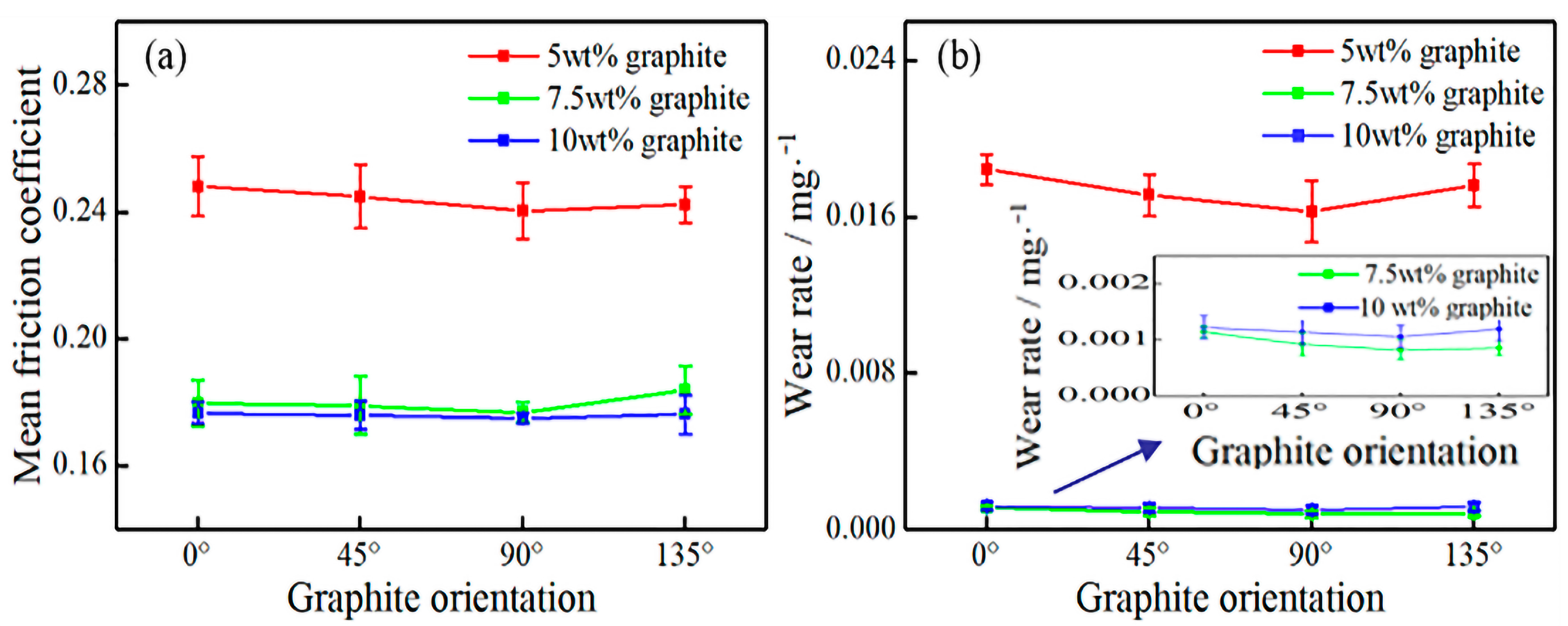
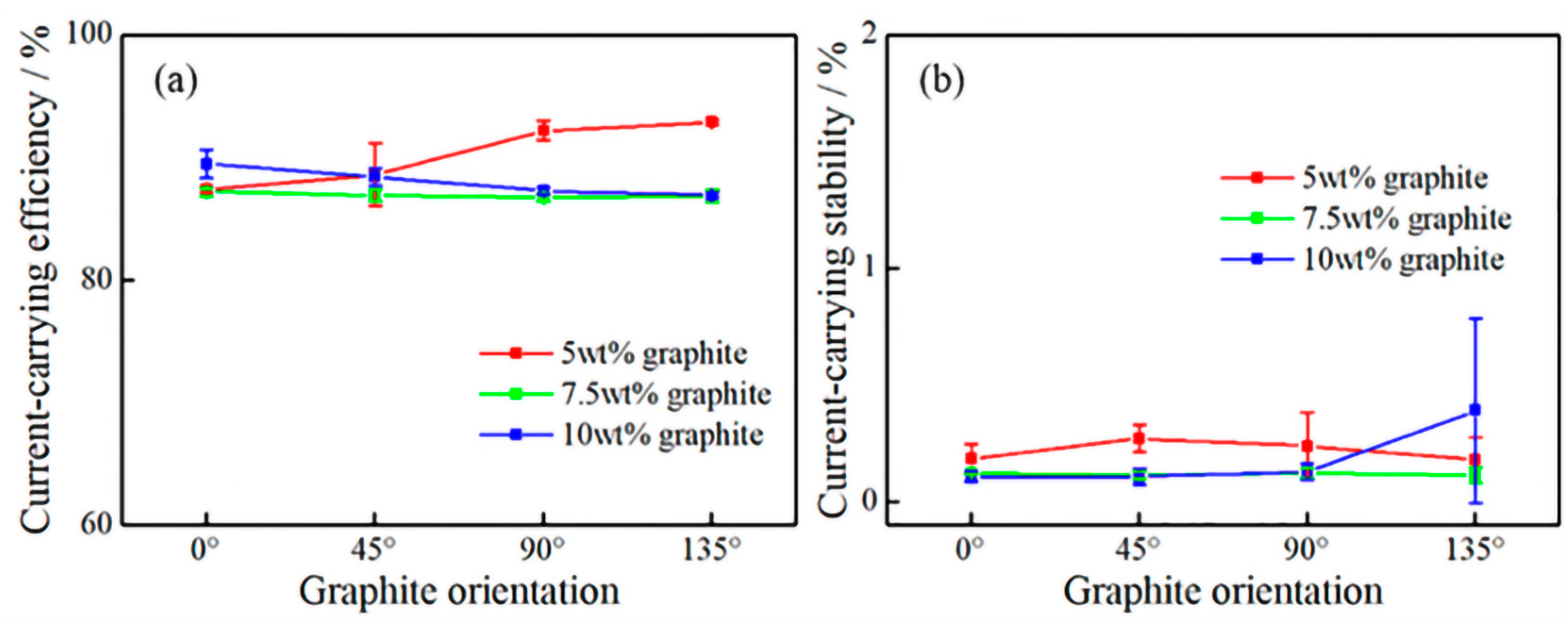
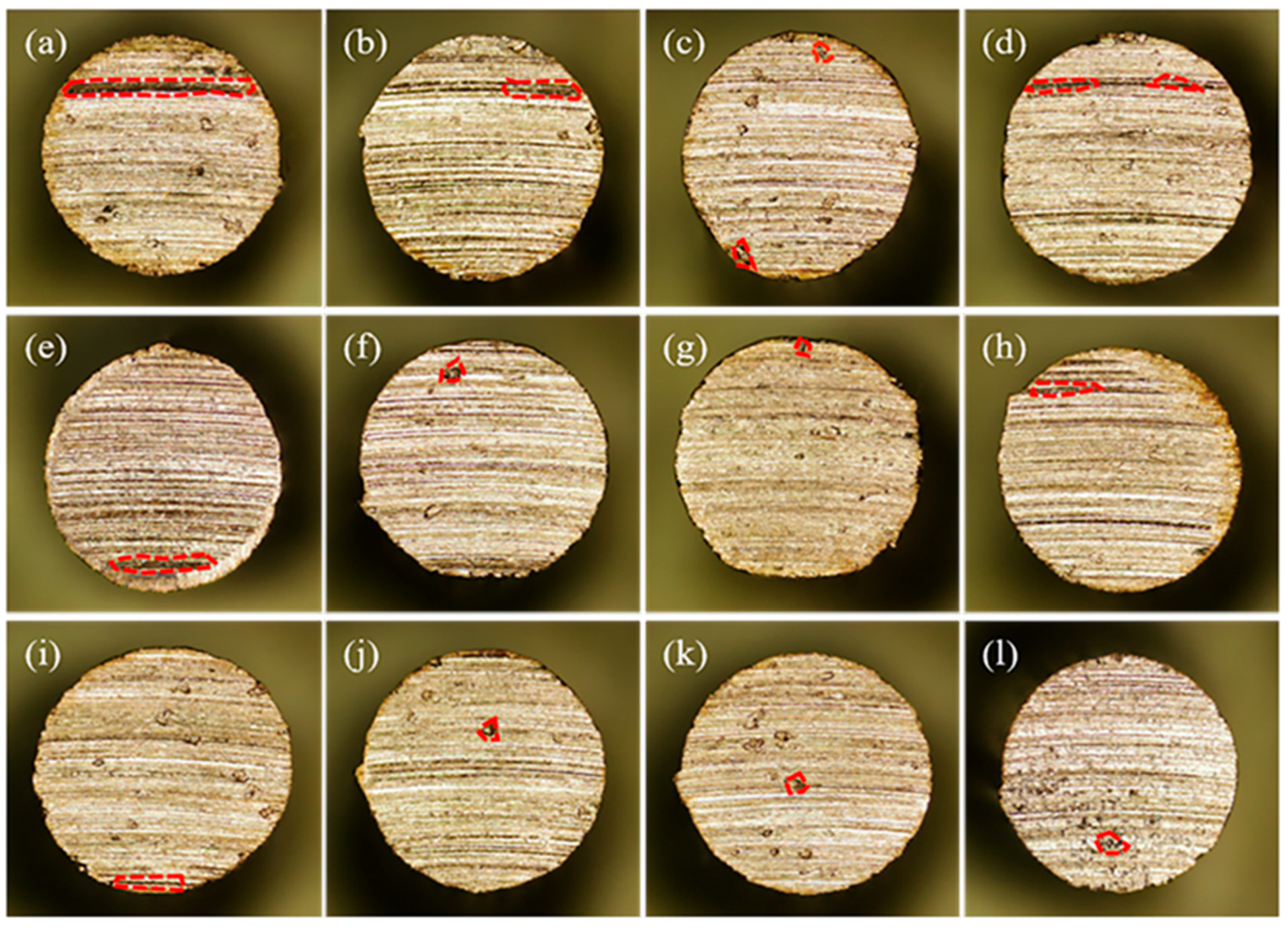
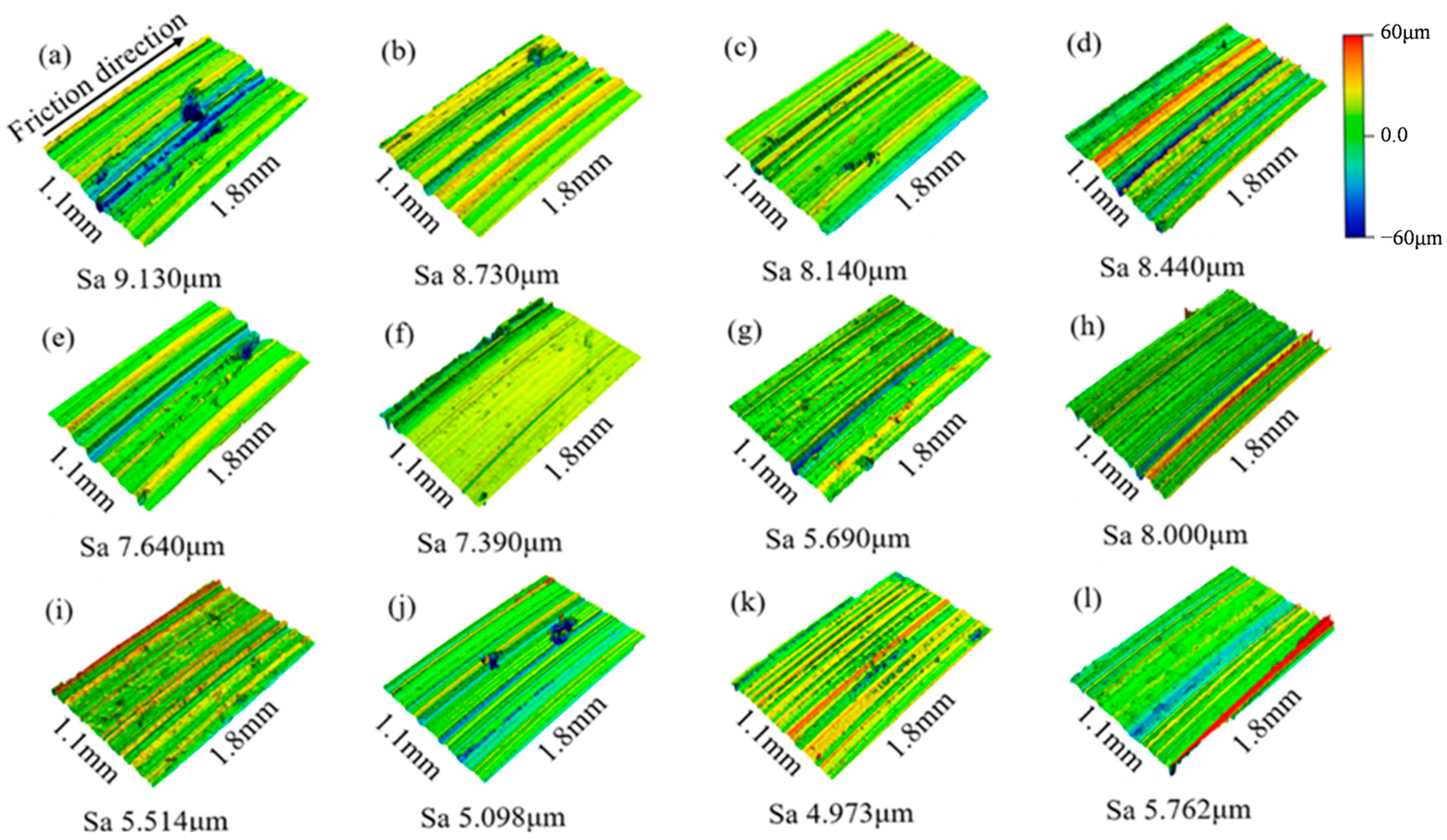
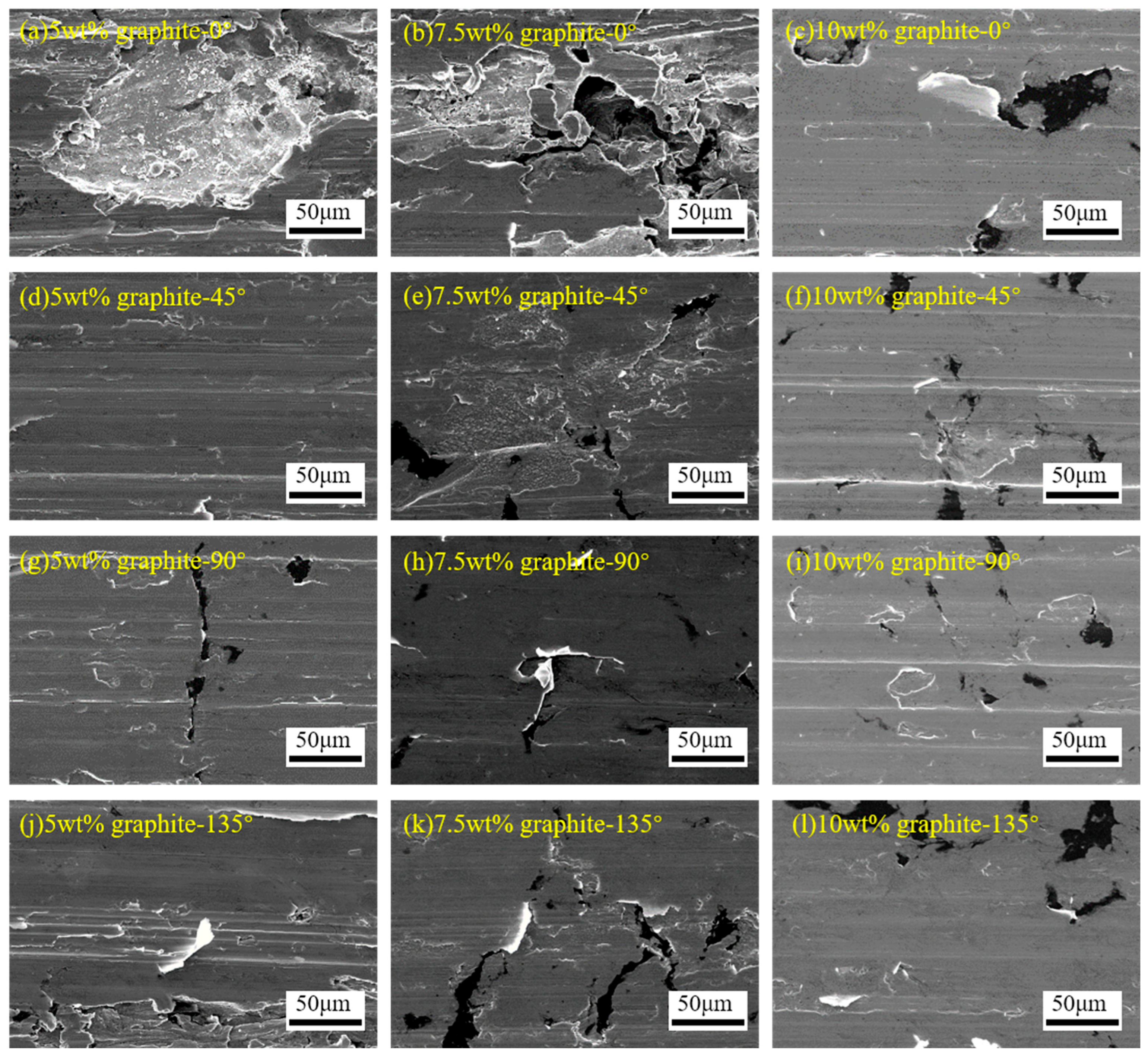

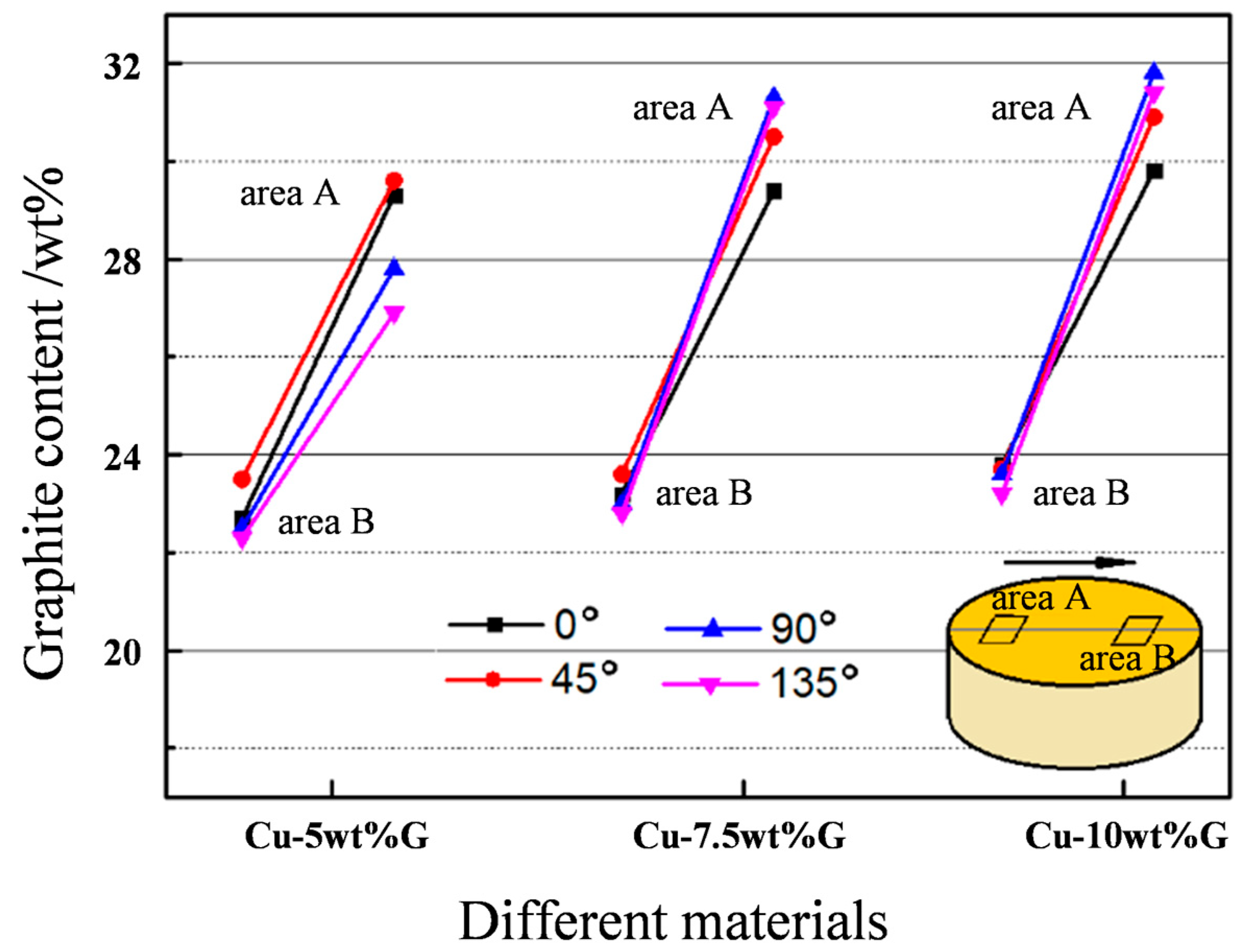


Disclaimer/Publisher’s Note: The statements, opinions and data contained in all publications are solely those of the individual author(s) and contributor(s) and not of MDPI and/or the editor(s). MDPI and/or the editor(s) disclaim responsibility for any injury to people or property resulting from any ideas, methods, instructions or products referred to in the content. |
© 2025 by the authors. Licensee MDPI, Basel, Switzerland. This article is an open access article distributed under the terms and conditions of the Creative Commons Attribution (CC BY) license (https://creativecommons.org/licenses/by/4.0/).
Share and Cite
Yang, Z.; Li, W.; Song, Y.; Zheng, X.; Zhang, Y. The Influence of Graphite Orientation on the Current-Carrying Friction Performance of Copper–Graphite Composite Materials. Lubricants 2025, 13, 238. https://doi.org/10.3390/lubricants13060238
Yang Z, Li W, Song Y, Zheng X, Zhang Y. The Influence of Graphite Orientation on the Current-Carrying Friction Performance of Copper–Graphite Composite Materials. Lubricants. 2025; 13(6):238. https://doi.org/10.3390/lubricants13060238
Chicago/Turabian StyleYang, Zhenghai, Wenbo Li, Yingjian Song, Xiaomeng Zheng, and Yongzhen Zhang. 2025. "The Influence of Graphite Orientation on the Current-Carrying Friction Performance of Copper–Graphite Composite Materials" Lubricants 13, no. 6: 238. https://doi.org/10.3390/lubricants13060238
APA StyleYang, Z., Li, W., Song, Y., Zheng, X., & Zhang, Y. (2025). The Influence of Graphite Orientation on the Current-Carrying Friction Performance of Copper–Graphite Composite Materials. Lubricants, 13(6), 238. https://doi.org/10.3390/lubricants13060238



